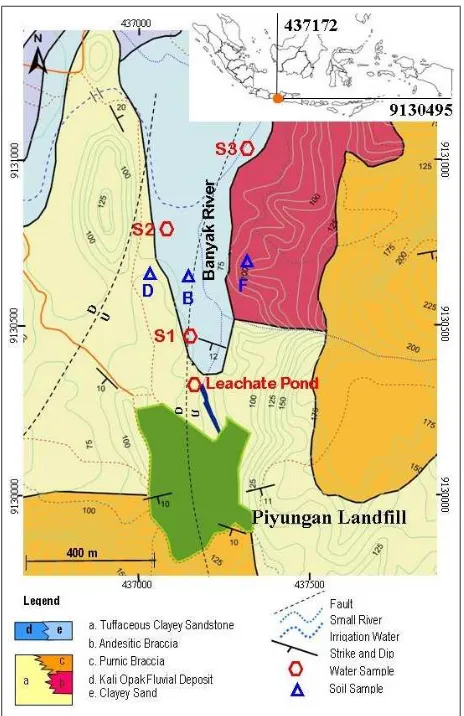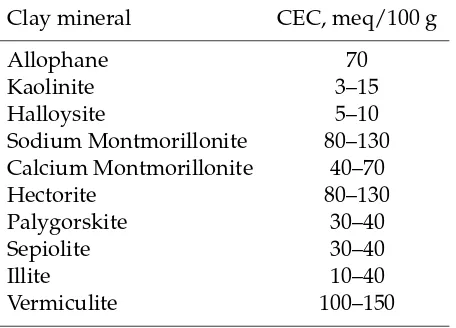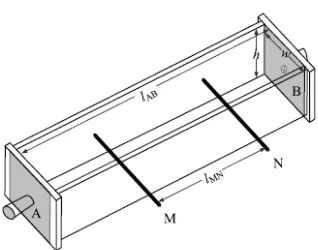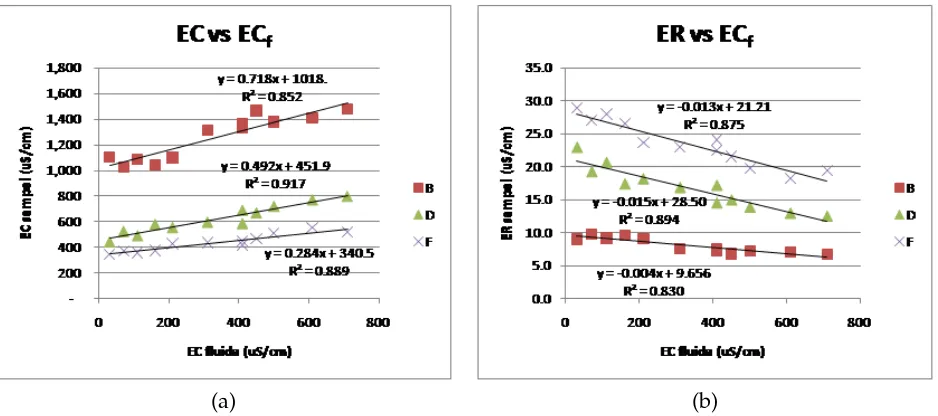DOI: http://dx.doi.org/10.22146/jag.26956
The Effect of Differences Leachate Concentration and Material Properties
on Electrical Conductivity of Volcanic Deposits – Case Studies Piyungan
Landfill Bantul Yogyakarta
Jaingot A. Parhusip∗1,2, Agung Harijoko1, Doni Prakasa Eka Putra1, and Wiwit Suryanto3
1Department of Geological Engineering, Faculty of Engineering, Gadjah Mada University, Yogyakarta, Indonesia 2Department of Mining Engineering, Faculty of Engineering, Cendrawasih University, Indonesia
3Department of Geophysics, Faculty of Mathematics and Natural Sciences, Gadjah Mada University, Indonesia
ABSTRACT. Monitoring at the contaminated subsurface soil, have been conducted by us-ing the geophysical surface method, especially for geoelectrical resistivity method. Mon-itoring is commonly conducted by using geoelectrical resistivity through measuring the value of Electrical Resistivity (ER) or Electrical Conductivity (EC) of leachate contami-nated soil layer. EC measurement value of soil is affected by many factors, among others, particle conduction of soil materials, surface conduction, fluid conduction in the pores as well as the effect of particle shape and soil materials. Piyungan landfill is the main dis-posal site of Yogyakarta municipal solid waste. This landfill located mainly on the tertiary rocks of volcanic rocks and its weathering products. In order to improve the accuracy of geoelectrical measurements on resistivity in monitoring soil layers from contaminated leachate on this area, this research conducted several measurements on physical proper-ties of soil sample and electrical properproper-ties of leachate in the saturated soil samples. The measurement of physical properties includes: porosity, clay content, particle content, and cation exchange capacity (CEC) value. The soil samples were collected from 3 locations around Piyungan Landfill. Type of soils are taken from the alluvial deposits (Sample B), weathered tuffaceous sandstone-claystone (Sample D), and weathered andesitic breccia (Sample F). Samples were made in containers, saturated with aquades-leachate solution with 12 different concentration levels. Electrical conductivity (EC) was measured by using Soil Box Miller and Geoelectric Resistivity Oyo McOhm. According to results of physical properties analysis, the grain size of soils are dominantly sandy clayey silt in grain size distribution, with clay content ranging from 33.0--38.4 %, the CEC values ranging from 26.8--52.7 meq/100 gr, and the porosity of samples B, D and F is 58.85 %, 55.30 %, 59.24 %, respectively. Based on the experiments with 12 different leachate concentrations, there is a linear increase in EC of 0.718µS/cm for every increase in electrical conductivity pore fluid (ECf) 1 mg/l in samples B, while in samples D and F are 0.492µS/cm and 0.284µS/cm
respectively. Plotting the data of EC vs ECf for each samples and ER vs ECf, it can be
concluded the slope of∆EC/∆ECf differ for each samples and the electrical conductivity value of different concentration of leachate is very sensitive for alluvial deposits compare to the weathered tuffaceous sandstone-claystone and weathered volcanic breccia deposits.
Keywords: Electrical conductivity·Cation exchange capacity·Leachate·Soil·Volcanic
deposits.
∗Corresponding author: J.A. PARHUSIP, Department
of Geological Engineering, Faculty of Engineering, Gad-jah Mada University. Jl. Grafika 2 Yogyakarta, Indonesia. E-mail: [email protected]
1 INTRODUCTION
the landfill often becomes a potential source of groundwater contamination because containing high concentration of chemical elements (Mac Farlane et al., 1983; Rapti-Caputo et al., 2006; Reyes-Lópezet al., 2008) . Therefore,in the land-fill dumping site it is necessary to monitor the probability of leachate seepagein the soil and groundwater continuously in the surrounding area of the landfill.
Many soil and groundwater quality monitor-ing at the contaminated subsurface soil, have been conducted by using the geophysical sur-face method, especially for geoelectrical resis-tivity method. Monitoring is conducted by us-ing geoelectrical resistivity through measurus-ing the value of Electrical Resistivity (ER) or Electri-cal Conductivity (EC) of leachate contaminated soil layer (Abbaspour et al., 2000; Meju, 2000; Porsani et al., 2004). EC measurement value of soil is affected by many factors, among oth-ers, particle conduction of soil materials, surface conduction, fluid conduction in the pores as well as the effect of particle shape and soil ma-terials. Electrical Conductivity of fluid (ECf) is
the dominant factor in measuring the EC value of soil, which is influenced by the chemical con-centration and composition of pore fluid (Mc-Carter, 1983; Kalinski and Kelly, 1994; Klein and Santamarina, 2003).
The purpose of this research to find the elec-trical characteristics of volcanic deposits satu-rated leachate as Piyungan landfill overlying such kind of lithology.Research conducted by Longo (2014) obtained ER value of volcanic deposits are between 4-20 Ohm-m (Longo et al., 2014). On this research, samples were obtained from the volcanic deposits around Piyungan landfill. This layer consists of allu-vial deposits, weathered andesitic breccia and weathered sandstone-tuffaceous claystone (Pu-tra, 2001). Data of ER or EC values of soil layer-ing and pore fluid filler is required as a binder to improve the accuracy of data interpretation of the soils layering lithology on the geoelectric resistivity measurements (Meju, 2000).
2 STUDYAREA
The areas of Piyungan Landfill and surround-ing are covered by Quarternary and Tertiary rocks, which are the Young Merapivolcanicde-posits, Alluvial Deposits and the lower-middle
Figure 1: Geological map (Putra, 2001) and soil sampling locations (B1, B2, B3, B4, D and F), leachate pond sample location, and groundwa-ter sample location from the dug well S1, S2 and S3.
Miocene rocks called as Semilir Formation (Ra-harjoet al., 1995).
The lithology contained in the study area can be divided into five lithological units, namely; sandstone-tuffaceousclaystone unit, andesitic breccia units, breccia pumice unit pumice which is a product of the tertiary rocks, and Opak River’s alluvial and fluvial deposition units and which is a quarternary deposit product (Putra, 2001). Banyak River is a disposal river for leachate from the Piyungan landfill, flowing across the alluvial deposits from the South to North (Figure 1).
3 THEORETICALBACKGROUND
with the electrical conductivity of clay material. EC material is represented by the Cation Ex-change Capacity (CEC) value of the clay:
EC= 1
F ECf +BQv
(1)
whereFis related to the porosityφwith Arcie equation of 1/F = φm in whichmis the poros-ity exponent of Archie equation with a value of m ≈ 2 and Bis the equivalent counter ion mo-bilityof clay surface.
where ECf is the electrolyte conductivity in
S.m−1 and the maximum counterion equiva-lent mobility is given by the value of B0 =
4.78×10−8 m2s−1V−1. Meanwhile, the Qv
value shows the CEC with an equation:
Qv =ρmat
(1−φ)
φ CEC (3)
whereρmatis the matrix density in kg.m−3.
The CEC values for some clay minerals are available in Table 1, ranging from 3-150 (meq/100gram) from Eslinger and Pevear (Is-madjiat al., 2015).
Table 1: The CEC values for some clay miner-als. The CEC values of clay ranging from 3--130 meq/100g, from Eslinger and Pevear (Ismadjiet al., 2015)
Clay mineral CEC, meq/100 g
Allophane 70
4 MATERIALS ANDMETHODS
Materials
Soil samples were collected from 6 locations around the Piyungan landfill, Yogjakarta (See Figure 1). Sampling were taken at a depth of
40-50 cm, except for the samples in location B that were taken from four different locations and depths. Point B1, B2, B3 and B4 are derived from a single point location with a depth of 1.0 m, 1.5 m, 2.5 m and 3.0 m, respectivley. Point B1, B2, B3, and B4 are in alluvial deposit. Point D is located at the location of the tuffaceous sandstone-claystone deposit, while point F is lo-cated at andesitic breccia unit. Each samples were made into two parts for the measurements of physical and electrical properties of the sam-ple. Groundwater samples were collected from dug well S1, S2 and S3. Leachate sample was collected from the leachate pond.
Measurements of physical and electrical prop-erties of the samples
a. Measurements on the physical properties of the soil; density, porosity, grain size dis-tribution and the value of the CEC, con-duct with the pycnometer, hydrometry and percolate distillation methods. The tests were conducted in the laboratory of Insti-tute for Agricultural Technology (BPTP) of Yogyakarta.
b. The measurement on the resistivity value of the sample was conducted in the labo-ratory of Environmental Geological Engi-neering of Gadjah Mada University of Yo-gyakarta. Each sample was dried for 3×24
hours. Each type of samples was then put into the 12 different sample containers with the same weight. Each sample was sat-urated with the aquades-leachate solution with 12 different levels concentration. The leachate was obtained from the leachate pond of Piyungan landfill. 11 samples used an aquades-leachate solution ranging from 10 mg/l to 350 mg/l and 1 sample used ground water. The samples were stirred evenly until the soil samples were satu-rated based on the standard (ASTM-G57a, 1995). There were 72 containers of satu-rated samples were then left for 24 hours to ensure saturation of samples. The satu-rated samples were then put into the soil box Miller (sketch in Figure 2), compacted evenly, and then measured for its EC values (Kowalzczyket al., 2014).
Figure 2: Soil box Millers scheme, A and B are the electrodes of electric current, M and N are the electrodes of electric potential. Electrodes A and B are made of stainless-steel fragments, with a thickness of 1 mm, and distance of 22cm. Electrodes M and N that are made of 4mm-diameter copper nails, with a length of 5cm, are made in a distant of 12 cm (ASTM-G57a, 1995).
McOhm. By using four electrodes method, 2 current electrodes and 2 potential elec-trodes, the current is conducted through the electrodes A and B that are made of stainless-steel fragments with a thickness of 1mm, and a distance of 22 cm. M and N electrodes that are made of 4 mm-diameter copper nails, with a length of 5 cm, are made in a distance of 12 cm. The data of sample resistivity were analyzed through graphics of the relationship of the effect of the level of EC change due to the increase of TDS concentration level of the pore fluid filler.
5 RESULTS ANDDISCUSSION
Physical properties
Physical properties of the sampless how on Ta-ble 2. According to the percentage value of the grain size, sample B, D and F are classified as sandy clayey silt. All samples had a total porosity of greater than 55 %. Weathered an-desitic brecciashas a porosity of 59.24 %, allu-vial deposits 58.85 % and weathered tuffaceous sandstone-claystone 55.30 %, respectively. Al-luvial deposit samples contain higher clay per-centage compare toweathered andesitic breccia and weathered tuffaceous clay sandstone.
However, the clay contain seem to be not lin-ear to the CEC value (see Figure 3). The CEC values are ranging from 26.8–52.7 meq/100gr.
Table 2: The physical parameter of lithology around Piyungan landfill (CEC in meq/100gr).
Soil ρ φ Sand Silt Clay CEC Sam- Total >50µ 2–50µ <2µ
ple (gr/cc) (%) (%) (%) (%)
B 2.48 55.30 14.50 46.70 38.80 32.94 D 2.53 58.85 18.67 44.67 36.67 26.60 F 2.48 59.24 26.67 40.33 33.00 36.40 B: Alluvial deposit
CD: Weathered tuffaceous sandstone-claystone F: Weathered andesitic breccias
Figure 3: The graphic of average clay content percentages and CEC values of volcanic de-posits around Piyungan landfill. The CEC val-ues are in meq/100g and clay content in %.
The highest CEC value measured on sample F of weathered andesitic breccia, and the low-est CEC measured from sample D of weathered tuffaceous sandstone-claystone.
Electrical conductivity measurements
The electrical conductivity values of samples with different combination of leachate con-centration is show in Table 3. The ground-water samples used in the measurements was from a dug well located approximately 650 m downstream from waste processing disposal of Piyungan landfill. The dug well has been clas-sify as contaminated by leachate from Piyungan landfill (Phonhalath, 2012). The ECf value of
this ground water is equal to the ECf value of
aquades-leachate fluid that result in different EC values (Parhusip,et al., 2016).
From the measurements, it can be obtained that the leachate-aquades solution with TDS values ranging from 10 mg/l to 350 mg/l has an EC value ranging about 30 µS/cm to 710µS/cm. There is an increase in EC linearly with the average increase of 0,82 µS/cm for every additional leachate TDS of 1 mg/l (Ta-ble 3). Concentration of TDS from 10 mg/l to 350 mg/l wi have EC of samples D and F are about 347µS/cm to 796µS/cm than samples B around 1027 uS/cm -1473 uS/cm. From Table 3, the value of ER can be calculated as ER is re-ciprocal value of EC. ER sample D, F and B are 19.3–28.8Ωm, 12.6–22.9Ωm 6.8–9.7Ωm, respec-tively. And if sample saturated with ground water ER for D, F and B are 17.2 Ωm, 24Ωm, and 7.5Ωm, respectively. All of the samples that were saturated by fluid aquades-leachate or by groundwater have increases in EC linearly due to the increase of ECf (Figure 4 and Table 4).
Table 3: The electrical conductivity values of samples B,D and F, after being saturated by aquades-leachatefluids with 12 different levels of TDS concentration.
Fluid Electrical Conductivity Sample (Aquades+leachate) (Aquades+leachate+soil)
TDS ECmud B D F
mg/L µS/cm µS/cm µS/cm µS/cm
10 30 1105 437 347
20 70 1027 520 370
50 110 1088 486 358 70 160 1043 575 377 100 210 1100 551 424 150 310 1312 593 436 200 410 1360 687 447 220 450 1462 667 466 250 500 1376 718 509 300 610 1405 769 549 350 710 1473 796 517 200* 410 1333 582 416
∗)groundwater
In Equation 1, it shows that EC is a function of the EC value of the electrolytes in the pores, where the density, porosity and CEC values of the samples are the constant magnitude as seen in Figure 4a. The graphic of the change of re-sistivity values of the sample towards the in-crease in ECf (Figure 4b) shows that the slope
of the graphic of samples D and F is higher than
Table 4: The equation of the graphs of EC value change versus the increase of ECf value and ΔEC/ΔECf value.
Sample Y R2 ΔEC/ΔECf (%)
B 0.718X+1018 0.852 71.8 D 0.492X+4519 0.917 49.2 F 0.284X+3405 0.889 28.4
of samples B. The slope of the graphic B is also greater than the graphic D and F. It is mean that the measurements of EC in the contaminated soil layers B, are more sensitive compare to the soil layers of D and F.
Comparing the physical properties of soils and results of the experiments (See Table 2 and Figure 4). It can be seen that the value of EC or ER have linear relationship with the clay content but not with CEC. The relationship is the highest the clay content, the highest the EC value, but for ER value, the highest the clay con-tent, the lowest the ER value. This fact shows how important the existing of clay content on the value of EC and or ER measurement.
6 CONCLUSION
Based on the experiments, it reveals that the change of EC value of the contaminated soil is more sensitive on the soil of alluvial de-positsthan soil from weathered tuffaceous sandstone-claystone and from weathered an-desitic breccia. It means that the increased conductivity of soil saturated leachate, will be higher in the alluvial depositscompared with the weathered tuffaceous clay sandstone and weathered andesitic breccia.
This condition will affect the electric resistiv-ity value of soils during the geoelectrical survey in the field. Different value of resistivity will be measured on the field of leachate contaminated area on different type of soils/rocks. Therefore, the data and results on this research can be used in the field as references to predict the contam-ination the leachate-saturated soil layer in the study area.
ACKNOWLEDGEMENTS
(a) (b)
Figure 4: (a).The graphic of the change in EC values towards the increase of ECf.values. (b). The graphics of the change in ER values towards the increase in ECfvalue.
by Postgraduate Education Scholarship. Our sincere thanks to the management of Piyun-gan Landfil, which has given us permission to do this research in the Piyungan landfill area. We also would like to give appreciation to the Head and staff of Department of Geological En-gineering, Gadjah Mada University, who gave the permission to access equipment and labora-tories. Last but not least, special thanks to Mr. Joko Riyanto for support during the laboratory works.
REFERENCES
Abbaspour, K., Matta V., Huggenberg, P., Johbson, C.A. (2000) A contaminated site investigation: comparison of information gained from geophysi-cal measurements and hydrogeologigeophysi-cal modeling. Journal of Contaminant Hydrology 40: 365-380. ASTM-G57a (1995) Standard method for field
mea-surement of soil resistivity using the Wenner four-electrode method.ASTM Designation: G57-95a: 211–215.
Ismadji, S., Soetaredjo, F.E., Citra, A.A. (2015) Clay materials for Environmental Remediation. Springer Briefs in Molecular Science, ISSN 2191-5415 (electronic).
Kalinski, R.J. and Kelly, W.E. (1994) Electrical-resistivity measurements for evaluating compacted-soil liners. Journal of Geotechnical Engineering 120: 451-457.
Klein, K.A. and Santamarina, J.C. (2003) Electrical Conductivity in soil. Journal of Environmental and Engineering Geophysics 8: 15-22
Kowalczyk, S.., Maslakowski, M., and Tucholka, P. (2014) Determination of the correlation between the electrical resistivity of non-cohesive soils and
the degree of compaction. Journal of Applied Geophysics 110: 43-50.
Longo. V., Testone, V., Oggiano, V. and Testa, A. (2014) Prospecting for clayminerals within vol-canic successions: Application of electrical resis-tivity tomography to characterise bentonite de-posits in northern Sardinia (Italy). Journal of Ap-plied Geophysics 111: 21-32.
Mac Farlane, D.S., Cherry, J.A., Gillham R.W., Su-dicky, E.A. (1983) Migration of contaminants in groundwater at a landfill: a case study. In: Cherry, J.A. (Ed.), Groundwater Flow and Plume Delin-eation. J. Hydrology. Special Issue 63:1-29. McCarter, W. (1984) The electrical resistivity
characteristics of compacted clays. Geotech-nique 34: 263-267. http://dx.doi.org/10.1016/ j.wasman.2008.03.024. Accesesed, 14 March 2016. Meju, M.A. (2000) Geoelectrical investigation of old/abandoned, covered landfill sites in urban areas: model development with a genetic diagno-sis approach. Journal of Applied Geophysics 44: 115-150
Parhusip, J.A., Harijoko, A., Putra, D.P.E., Suryanto, W. (2016) Electrical Conductivity of Ions Major and Heavy Metal Contribution for Electrolyte Electrical Conductivity of Leachate and Ground-water in Piyungan Landfill, Bantul Yogyakarta. Proceeding of Annual Basic Science International Conference Vol. 6: 201-205.
Phonhalath, K. (2012) Hydrogeological Control on Fate Processes of Heavy Metal and Organic Chemical Contaminants from Landfill, case study: Piyungan Landfill, Yogyakarta Special Province, Indonesia. Dissertation, Faculty Engi-neering Gadjah Mada University, pp.306.
delineating a contamination plume in a landfill site: a case study in SE Brazil. Journal of Applied Geophysics 55: 199-209.
Putra, D.P.E. (2001) Pencemaran Leachate Pada Air tanah di Area Tempat Pembuangan Akhir Sampah Piyungan dan Sekitarnya Kecamatan Piyungan Kabupaten Bantul Yogyakarta. Pro-gram Studi Teknik Geologi, Jurusan Ilmu ilmu Teknik-Program Pascasarjana UGM, Yogyakarta. Pp. 180.
Rahardjo, W., Sukandarrumidi, Rosidi (1995) Peta Geologi Lembar Yogyakarta, Jawa. Direktorat Ge-ologi Deptamben RI, Bandung.
Rapti-Caputo D., Vaccaro C. (2006) Geochemical
ev-idences of landfill leachate in groundwater. Engi-neering Geology 85: 111-121.
Reyes-López, J.A., Ramírez-Hernández, J., Lázaro-Mancilla, O., Carreón-Diazconti, C., Garrido, M.M.L. (2008) Assessment of groundwater con-tamination by landfill leachate: a case in México. Waste Management.
Waxman, M.H. and Smits, L.J.M. (1968) Electrical conductivities in oil bearing shally sands. Society of Petroleum Engineers Journal 8: 107–122. Sen, P.N., Goode, P.A., Sibbit , A. (1988) Electrical




